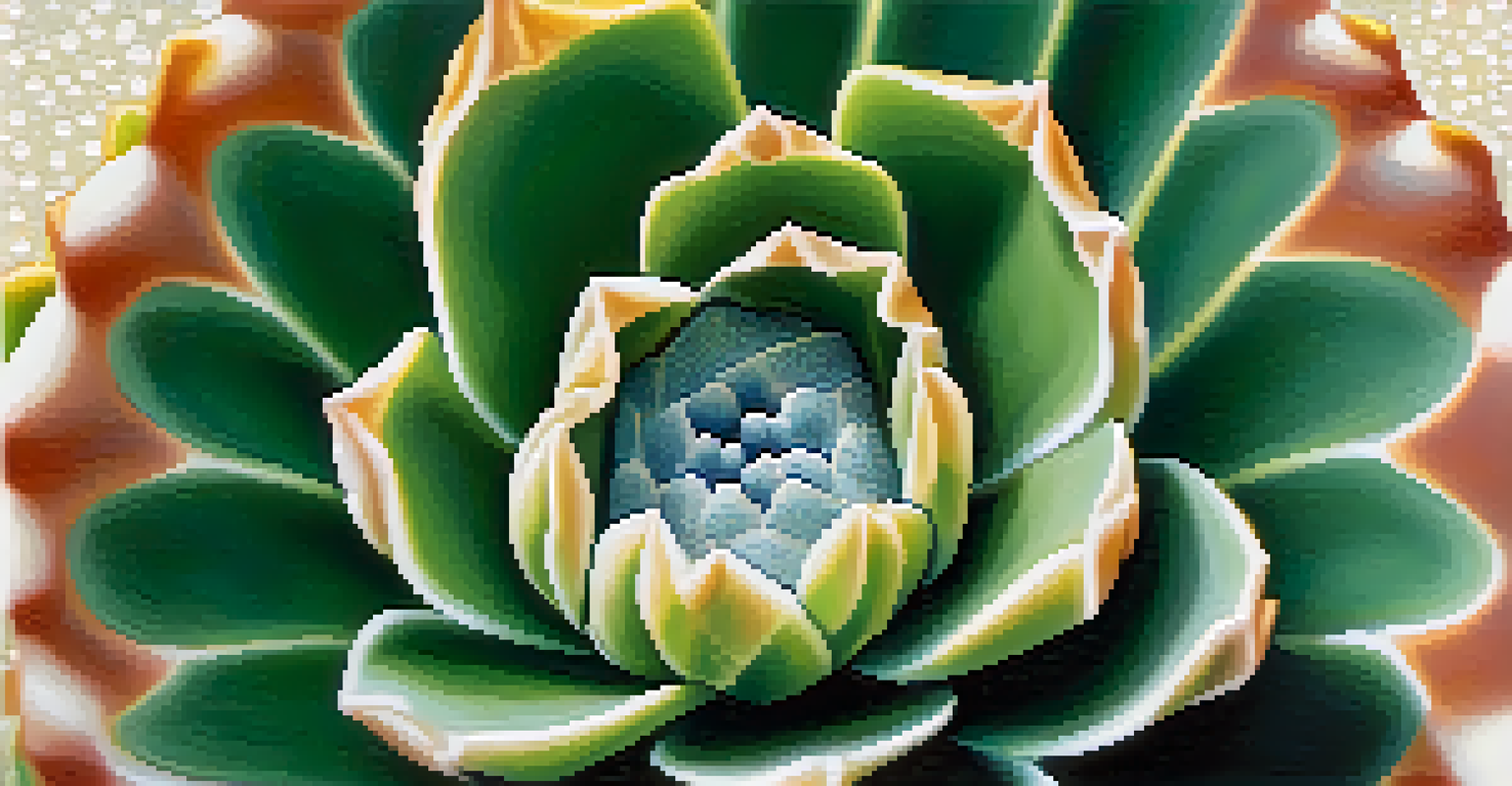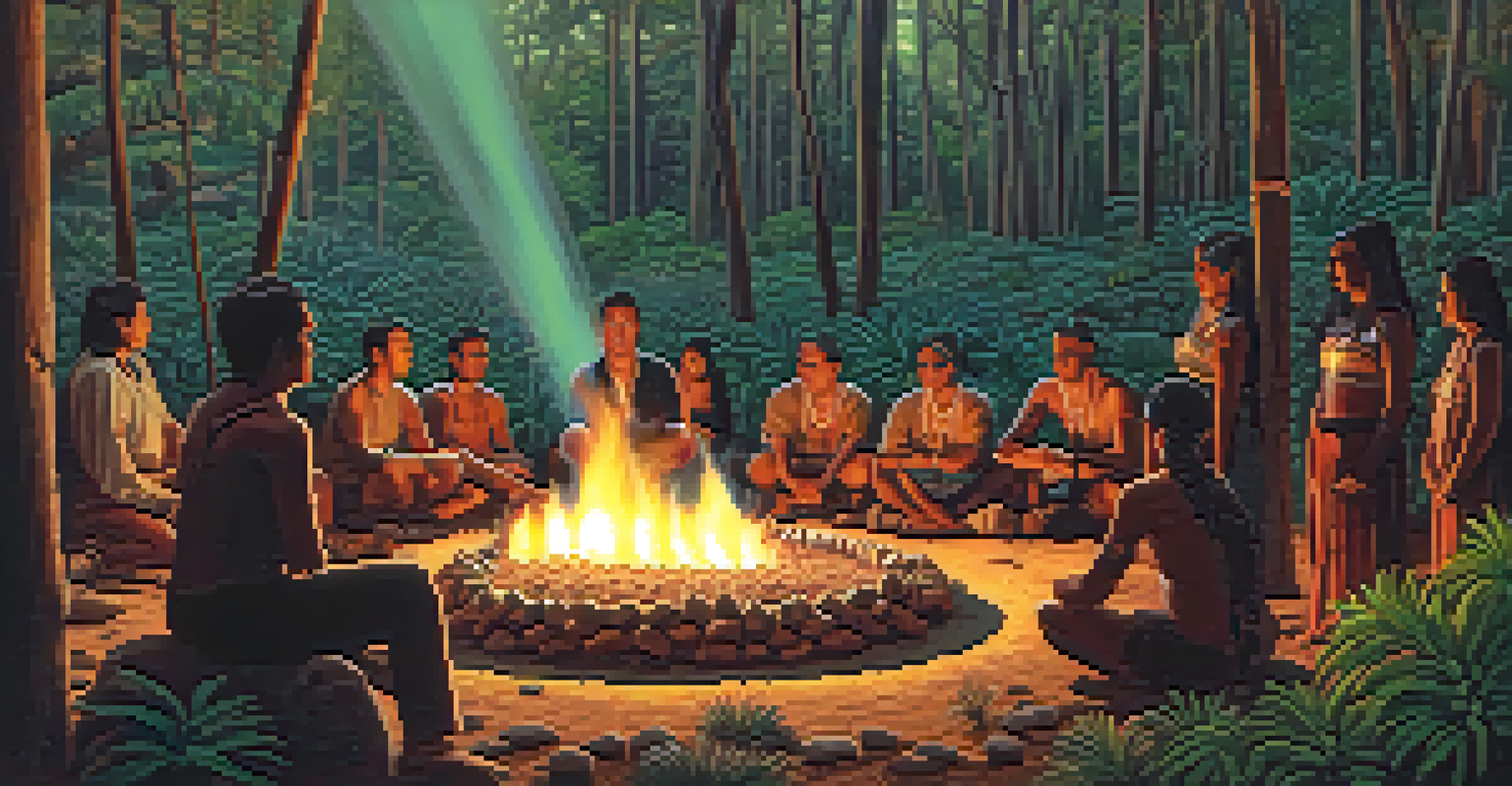Psychedelic Experiences: Peyote's Influence on Spirituality

Understanding Peyote: A Brief Overview of the Cactus
Peyote is a small, spineless cactus native to the southwestern United States and Mexico. Known scientifically as Lophophora williamsii, it has been used for centuries by Indigenous peoples for its psychoactive properties. The primary compound responsible for its effects is mescaline, a psychedelic substance that alters perception and consciousness. This cactus is more than just a plant; it’s a gateway to profound spiritual experiences.
The cactus that teaches us how to heal is the one we should cherish the most.
Traditionally, peyote has been used in various rituals, often serving as a tool for healing and spiritual guidance. Many Indigenous cultures view it as a sacred medicine, integral to their spiritual practices. The experiences induced by peyote are often described as transformative, offering insights that can lead to personal growth and a deeper understanding of the self and the universe.
As we explore the influence of peyote on spirituality, it’s essential to appreciate its cultural significance. Understanding this context helps us appreciate the depth of the experiences that peyote can facilitate, connecting users to their heritage and the natural world.
The Psychedelic Experience: What Happens Under Peyote's Influence?
When individuals consume peyote, they enter a unique state of consciousness, often characterized by vivid visual and auditory hallucinations. Users frequently report enhanced sensory perception, where colors seem more vibrant and sounds resonate deeply. This altered state can lead to profound introspection and emotional release, allowing individuals to confront and process their thoughts and feelings.

The journey typically lasts 10 to 12 hours, during which people may experience feelings of unity with nature and a connection to something greater than themselves. Many describe moments of clarity, where personal truths and universal themes become apparent. This sense of interconnectedness is a common thread in psychedelic experiences, fostering a deep appreciation for life and existence.
Peyote's Role in Spiritual Awakening
Peyote serves as a powerful catalyst for personal transformation and spiritual clarity, connecting individuals to their inner selves and communities.
However, it's important to approach these experiences with respect and caution. The setting and mindset play crucial roles in shaping the journey, and the potential for challenging experiences exists. For many, these challenges can lead to breakthroughs, but understanding the full scope of what to expect is essential for a safe and meaningful experience.
Spiritual Awakening: Peyote as a Catalyst for Change
Many individuals turn to peyote for spiritual awakening, seeking answers to life's profound questions. The experiences often facilitate a sense of clarity that encourages personal development and transformation. Users frequently report feeling a renewed sense of purpose and direction, which can be life-altering.
Psychedelics are a means to access the deeper aspects of the self and the universe, revealing the interconnectedness of all beings.
This catalyst for change is not just about individual insights; it often leads to a stronger connection with community and culture. Peyote ceremonies typically involve group settings, where participants share their experiences, fostering a sense of belonging and mutual support. This communal aspect enhances the spiritual journey, emphasizing the importance of shared experiences.
Ultimately, peyote serves as a reminder of the interconnectedness of all beings. By engaging with this sacred cactus, individuals often find themselves not only transformed personally but also more engaged with their communities and the larger world around them.
Cultural Significance: Peyote in Indigenous Spiritual Practices
Peyote holds profound cultural importance among various Indigenous groups, particularly within Native American spirituality. It is often used in traditional ceremonies, such as the Native American Church, where it plays a central role in worship and healing. These ceremonies are designed to promote spiritual growth, mental health, and community bonding.
The rituals surrounding peyote use are steeped in tradition, often involving prayers, songs, and communal gatherings. Participants believe that the cactus can aid in healing both physical and spiritual ailments, making it a vital part of their cultural identity. This deep-rooted connection to peyote reflects broader themes of respect for nature and the pursuit of spiritual knowledge.
Cultural Significance of Peyote
Peyote is deeply embedded in Indigenous traditions, playing a vital role in ceremonies that promote healing and spiritual growth.
Understanding this cultural context is crucial for anyone interested in exploring peyote. It’s not merely a substance to be consumed; it is a sacred tool that has the potential to bridge the gap between the physical and spiritual realms, embodying a rich history of Indigenous beliefs and practices.
Modern Perspectives: Peyote in Today’s Spiritual Landscape
In recent years, there has been a resurgence of interest in psychedelics, including peyote, as tools for spiritual exploration. This renewed attention often intersects with the growing wellness movement, where individuals seek alternative paths to healing and self-discovery. Many are drawn to peyote for its potential to foster spiritual awakening and personal insights.
However, this modern interest comes with challenges, particularly regarding the sustainability of peyote populations. Overharvesting and habitat loss pose significant threats to this sacred plant, prompting discussions about ethical use and conservation efforts. Engaging with peyote today means not only appreciating its spiritual impact but also advocating for its preservation.
Furthermore, the dialogue around peyote often emphasizes the importance of respecting Indigenous traditions. As more people explore these experiences, there’s a growing awareness of the need to honor the cultural significance of peyote, ensuring that Indigenous voices are heard and respected in discussions surrounding its use.
Navigating the Challenges: Risks and Considerations of Peyote Use
While peyote offers transformative experiences, it’s essential to acknowledge the potential risks involved. Not everyone responds positively to psychedelics, and some may experience anxiety or confusion during their journey. Understanding these risks is crucial for anyone considering using peyote, as preparation and awareness can significantly influence the outcome of the experience.
For safe usage, it’s vital to approach peyote with respect and intention. Setting, mindset, and the presence of experienced guides can make a significant difference in navigating the journey. Many individuals find that participating in structured ceremonies led by knowledgeable facilitators can enhance the experience, providing support and context for the insights gained.
Modern Challenges with Peyote Use
As interest in peyote rises, concerns about its sustainability and the need to respect Indigenous practices become increasingly important.
Moreover, integrating the lessons learned from a peyote experience into daily life requires reflection and support. Many participants benefit from discussing their journeys with others, allowing them to process and apply their newfound understandings in a meaningful way.
Conclusion: The Lasting Impact of Peyote on Spirituality
Peyote’s influence on spirituality is profound, offering individuals a unique lens through which to explore their inner worlds. The combination of its rich cultural history and the powerful experiences it can induce makes it a significant tool for many seeking deeper connections to themselves and their surroundings. Whether through traditional ceremonies or modern explorations, peyote continues to inspire spiritual journeys.
As we navigate the complexities of using peyote, it’s essential to approach this sacred cactus with reverence and care. By understanding its cultural significance and the potential risks involved, individuals can engage with peyote responsibly, ensuring that their experiences are both meaningful and respectful.

Ultimately, peyote serves as a bridge between the physical and spiritual realms, reminding us of the interconnectedness of all life. As more people seek out these experiences, the dialogue around peyote will continue to evolve, fostering a greater appreciation for its role in spirituality and the need for its preservation.